Keywords
|
| MANET, AODV, AOMDV, DELAY, NS-2. |
I. INTRODUCTION
|
| A mobile ad-hoc network (MANET) could be a assortment of mobile nodes sharing a wireless channel with none centralized management or established communication backbone. They need no mounted routers with all nodes capable of movement and at random dynamic. These nodes will act as each end systems and routers at an equivalent time. Once acting as routers, they discover and maintain routes to different nodes within the network. The topology of the ad-hoc network depends on the transmission power of the nodes and the location of the mobile nodes, which may change from time to time [1]. |
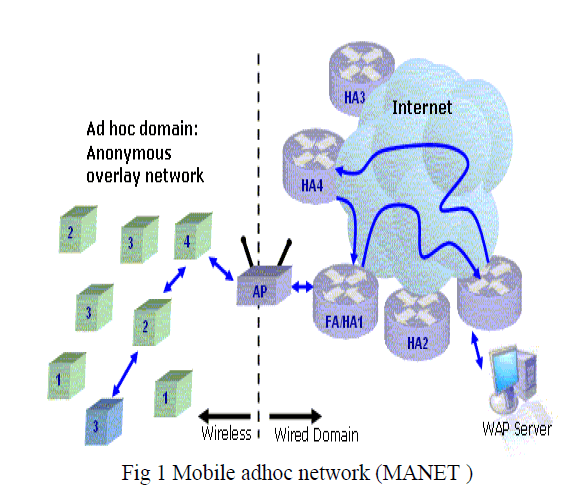 |
| Dynamic topology: Nodes are free to move arbitrarily in any direction thus the topology of the network change unpredictably. |
| Limited Bandwidth: the bandwidth available for wireless networks is generally low than that of wired networks. |
| The throughput of those networks is usually low due varied noises, weakening effects. |
| Energy constrained operation: the nodes are portable devices and are dependent on batteries. This is the most important design consideration of the Mobile adhoc network (MANET). |
| Security: wireless networks are more prone to threats than wired networks. The increased possibility of various security attacks like eavesdropping, denial of service should be carefully. |
| [17] One of the most issues in ad-hoc networking is that the efficient deliveries of information packets to the mobile nodes wherever the topology isn't pre-determined nor will the network have centralized management. Hence, as a result of the often dynamic topology, routing in ad-hoc networks may be viewed as a challenge. Efficient of data packet transmission is that the main goal in Mobile adhoc network (MANET). End-to-End delay is that the most vital issue for assessing the quality of Service. it's the time taken by a node, to sense, to method and to speak with different nodes. It conjointly depends on the scope of an application. Time delay in a network is find based on these activities as well as how much time a node takes to forward the info in significant load traffic. Once giant numbers of nodes area unit uniformly deployed to transmit the data packets then, the network should be able to offer the guarantee of low-delay and low-error rate [2].Second challenge of Mobile adhoc network (MANET) is to route with low overheads even when conditions are dynamic. Overhead here is defined in terms of routing protocol control messages which consume both channel bandwidth as well as the battery power of nodes for communication and processing. Several studies on performance comparisons [3, 4].AODV protocols in ad-hoc networks utilize the single route that is built for source and destination node pair. Due to node mobility, node failures and the dynamic characteristics of the radio channel, links in a way may become temporarily unavailable, making the route invalid [5]. The overhead of finding alternative routes mounts along with additional packet delivery delay. This problem can be solved by use of multiple paths between source and destination node pairs, where one route can be used as the primary route and the rest as backup. Performance can be adversely affected by high route discovery latency and frequent route discovery in dynamic networks. This can be reduced by computing multiple paths in a single route discovery attempt. Multiple paths can be formed for both traffic sources and intermediate nodes with new routes being discovered only when needed, reducing route discovery latency and routing overheads. Multiple paths can also balance network load by forwarding data packets on multiple paths at the same time. There area unit several routing protocols offered. This paper considers AODV and AOMDV for performance comparisons. These protocols area unit analysed supported the vital metrics like throughput, packets lost, quality of services and End-to-End Delay. The remainder of the paper is organized as follows. Section two describes two routing protocols AODV and AOMDV of MANETs. Section three show performance metrics. The results of simulations present in section four. Finally section five defines conclusion and future work. |
| A. ADHOC ROUTING PROTOCOLS |
| A Mobile Ad-hoc Network (MANET) is a dynamic wireless network will be formed without the necessity for any preexisting infrastructure during which every node can act as a router. A fundamental assumption in ad-hoc networks is that any node will be accustomed forward packets between absolute sources and destinations. Some variety of routing protocol is required to form the routing choices. A wireless ad-hoc environment introduces several issues like mobility and limited bandwidth that makes routing troublesome. [5] This paper compares the AODV and AOMDV Mobile adhoc protocols on the idea of Quality of Services parameters like throughput, Delay, overhead and packets lost. In this section, we have given a quick review of routing protocols that are developed as associate extension to the AODV routing protocol under varied situations. Ad–hoc on demand distance vector routing (AODV) may be a stateless ondemand routing protocol. [5] The Ad-hoc On Demand Distance Vector (AODV) classified beneath reactive protocols. The operation of the protocol is split in two in, route discovery and route maintenance. In Ad-hoc routing, once a route is required to some destination, the protocol starts route discovery. Then the supply node sends route request message to its neighbours. And if those nodes don\'t have any info regarding the destination node, they\'re going to send the message to all or any its neighbours then on. And if any node has the data regarding the destination node, the node sends route reply message to the route request message leader. On the idea of this method a path is recorded within the intermediate nodes. This path identifies the route and is termed the reverse path. Since every node forwards route request message to all or any of its neighbours, over one copy of the initial route request message will make a node. a unique id is allotted, once a route request message is made. Once a node received, it will check this id and therefore the address of the leader and discarded the message if it had already processed that request. Node that has data regarding the path to the destination sends route reply message to the neighbours from that it\'s received route request message. These neighbours will constant. Because of the reverse path it will be attainable. Then the route reply message travels back exploitation reverse path. Once a route reply message reaches the instigator the route is prepared and therefore the instigator will begin sending information packets. The key steps of algorithm used by AODV for establishment of unicast routes are explained below. |
| 1. ROUTE DISCOVERY |
| [6] When a node desires to send a data packet to a destination node, the complete route in table are checked to confirm whether or not there\'s a current route thereto destination node or not. If it\'s there, the info packet is forwarded to the suitable next hop toward the destination. If it\'s not there, the route discovery process is initiated. AODV initiates route discovery method exploitation Route Request (RREQ) and Route Reply (RREP). The supply node can produce a RREQ packet containing its ip address, its current sequence range, the destination’s ip address, the destination’s last sequence range and broadcast ID. the broadcast ID is incremented anytime the source node initiates RREQ. Basically, the sequence numbers area unit wont to verify the timeliness every of every} information packet and therefore the broadcast ID & the ip address along type a unique symbol for RREQ thus on uniquely determine each request. The requests area unit sent using RREQ message and therefore the data in connection with creation of a route is sent back in RREP message. The sending node broadcasts the RREQ packet to its neighbours and so sets a timer to attend for a reply. To method the RREQ, the node sets up a reverse route entry for the supply node in its route table. This helps to understand a way to forward a RREP to the supply. Primarily a lifespan is related to the reverse route entry and if this entry isn\'t used inside this lifespan, the route data is deleted. If the RREQ is lost during transmission, the sending node is allowed to broadcast once more using route discovery mechanism. [6] Expanding Ring Search Technique: The source node broadcasts the RREQ packet to its neighbours which in turn forwards the same to their neighbours and so forth. In case of large network, there is a need to control network broadcasts of RREQ and to control the same; the source node uses an expanding ring search technique. The source node sets the Time to Live (TTL) value of the RREQ to an initial start value. If no reply within the discovery period, the next RREQ is broadcasted with a TTL value increased. The process of incrementing TTL value continues until a threshold value is came, after which the RREQ is broadcasted across the entire network. |
| 2. SETTING UP OF FORWARD PATH |
| [11] When the destination node or associate intermediate node with a route to the destination receives the RREQ, it creates the RREP and unicast an equivalent towards the source node mistreatment the node from that it received the RREQ because the next hop. Once RREP is routed back on the reverse path associated received by an intermediate node, it sets up a forward way entry to the destination in its routing table. Once the RREP reaches the supply node, it suggests that a route from source to the destination has been established and also the source node will begin the info transmission. |
| 3. ROUTE MAINTENANCE |
| [16] A route discovered between a source node and destination node is maintained as long as needed by the source node. Since there's movement of nodes in mobile unplanned network and if the source node moves throughout a lively session, it will reinitiate route discovery mechanism to determine a replacement route to destination. Conversely, if the destination node or some middle node moves, the node upstream of the break initiates Route Error (RERR) message to the affected active upstream nodes. Subsequently, these nodes propagate the RERR to their predecessor nodes. This procedure continues till the source node is reached. Once RERR is received by the source node, it will either stop sending the info or reinitiate the route discovery mechanism by causation a replacement RREQ message if the route remains needed. |
| The benefits of AODV protocol are that it favors the smallest amount congested route rather than the shortest route and it conjointly supports each unicast and multicast packet transmissions even for nodes in constant movement. It also responds terribly quickly to the topological changes that affects the active routes. AODV doesn't place any extra overheads on information packets because it doesn’t create use of supply routing. |
| The limitation of AODV protocol is that it expects/requires that the nodes within the mass medium will discover every others’ broadcasts. It’s conjointly doable that a sound route is expired and also the determination of an inexpensive end time is troublesome. the rationale behind this is often that the nodes ar mobile and their causation rates might take issue wide and might amendment dynamically from node to node. Additionally, because the size of network grows, varied performance metrics begin decreasing. AODV is prone to varied forms of attacks because it supported the belief that every one nodes should get together and while not their cooperation no route is established. |
| B.LITRETURE SURVEY |
| The motivation of multipath routings is clearly to reduce the overhead and to guarantee a better network load balancing. Many studies have been conducted comparing AODV to other routing protocols in terms of Packet delivery ratio, Average end-to-end delay etc. subjected to change in no. of nodes and traffic type. One such simulation result is shown in [13]. AOMDV performs better than AODV in terms of all above stated parameters. A number of modifications have been done on AODV to increase its performance in terms of various parameters. The AODV protocol needs to discover the route first in order to send the actual data. This results in search latency effects of this protocol. To decrease route discovery rate in single path routing, some multipath routing protocols proposed to extend AODV [11], [6], and [15]. |
| Mallapur Veerayya et al. in [16] proposed an energy-aware routing protocol for Quality-of-Service (QoS) support in an infrastructure-less ad-hoc network. The distinctiveness in their scheme was that it used only local data, requires no additional communication or co-operation between nodes. |
| Simmi Jain in [15] proposed a solution to improve multipath functionality in pure AODV protocol that helps to improve the performance of routing protocol for selecting best route and identification of misbehaving nodes. Abderrahmen Mtibaa and Farouk Kamoun proposed a hybrid protocol MMDV in [14] that extends the AODV protocol with a dynamic MPR (Multipoint Relays) and multiple paths. Simulation results show that AOMDV enhance the packet delivery performance and reduce the overhead in comparison to AODV. |
| N.Jaisankar and R.Saravanan[7] proposed a multipath routing scheme which provides better performance and scalability by computing multiple routes in a single route discovery. They claimed the proposed scheme was better than AODV in discovering and maintaining routes.. [12] Extends AODV to discover multiple paths |
| distance vector concept and uses hop-by-hop routing approach. Mahesh K. Marina and Samir R. Das [9] developed AOMDV with the route discovery and route maintenance phase similar to AODV. The main difference lies in the route discovery process which has been modified to enable multiple paths. The basic structure of a routing table entry in the AOMDV in comparison to AODV is altered [8]. There are two main differences: |
| (i) The hop-count is replaced by advertised hop-count in the AOMDV. |
| (ii) The next hop is replaced by the route list. |
| AOMDV is intended to provide efficient recovery from route failures and efficient fault tolerance. To achieve these goals, it computes multiple loop-free and disjoint alternate paths at every node [4]. A stress is given on link disjointness of multiple paths such that the paths may share nodes but no edges. Two main components of AOMDV process are- (i) A route update rule to establish and maintain multiple loop-free paths at each node. |
| (ii) A protocol to find link-disjoint paths. |
| When an intermediate node receives route request it sets the reverse path to all the multiple paths that are legal and sends a path reply to source node. Same process is repeated by the destination when it receives a route request [4]. As stated in [12] duplicate copies of a RREQ are not discarded. Each packet is examined to see if it provides a nodedisjoint path to the source .Route maintenance in AOMDV is also similar to that in AODV. The difference is that, in AOMDV, a node only forwards a RERR packet for a destination when all paths to the destination break.all the multipath routing protocols use the data flow to update the time-tags of the paths and keep them fresh, AOMDV makes use of periodic HELLO messages to detect the validity of the links. |
| Many performance comparisons have been done between AODV and its multipath extensions. Simulations by [9] show that AOMDV reduces the packet loss by up to 40% and reduces routing overhead by about 30% by reducing the frequency of route discovery operations. [11]States The advantage of using AOMDV is that it allows intermediate nodes to reply to RREQs, while still selecting disjoint paths. Abdulsalam Alammari et al. [1] consider restriction of link-disjoint routes a vital drawback of AOMDV. Many efficient routes can be missed, which leads to consumption of too much memory with increase in routing overhead. AOMDV deletes links when they seem to be failed and sometimes considers congested links as broken links. It removes such paths from the list.Use of a large number of control packets for measure and maintaining multiple routes between a source and destination is also a drawback of AOMDV [6]. |
II. SIMULATION SETUP & RESULT
|
| To perform the comparison between AODV and AOMDV protocols first we installed the ns-2 simulator to make A mobile ad-hoc network (MANET). |
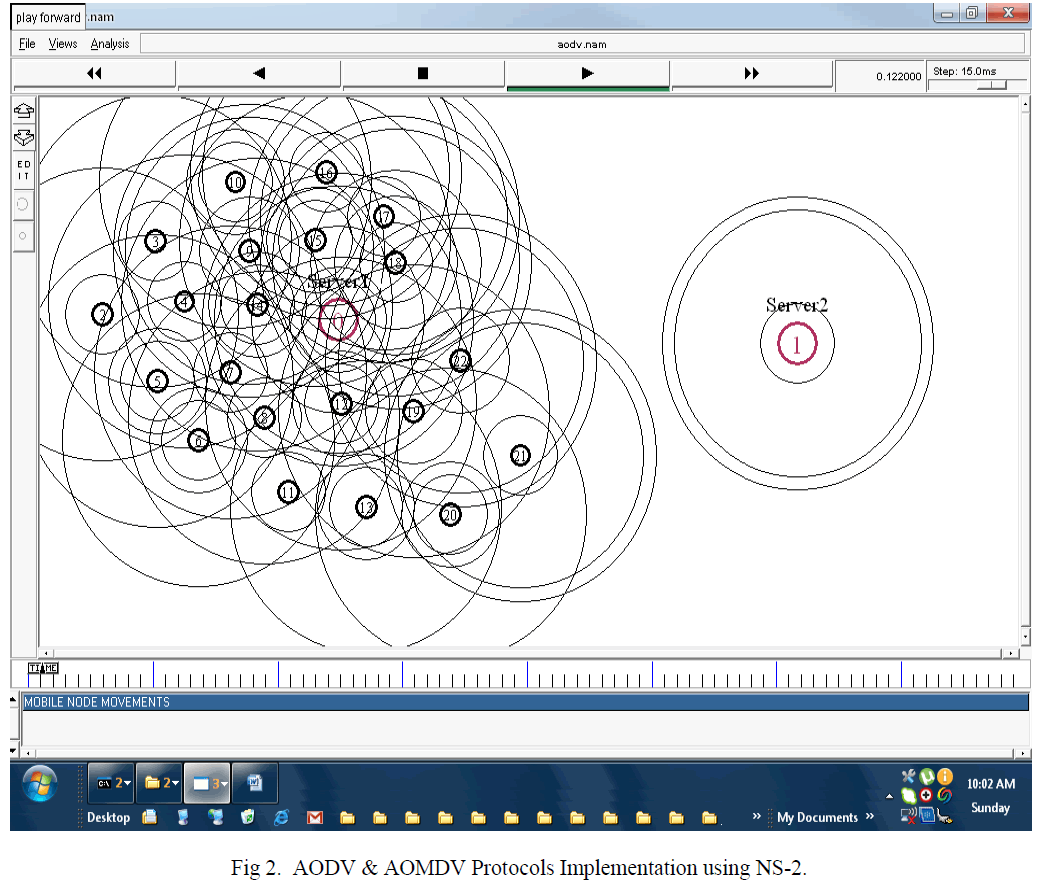 |
| In Figure 2 show implementation of mobile ad-hoc network (MANET) based on AODV and AOMDV using NS-2 simulator. This scenario show 20 nodes are connected by server and tried to make coverage with each other. In Figure 3 all 20 nodes are connected with server using AODV and AOMDV protocols in both scenarios. |
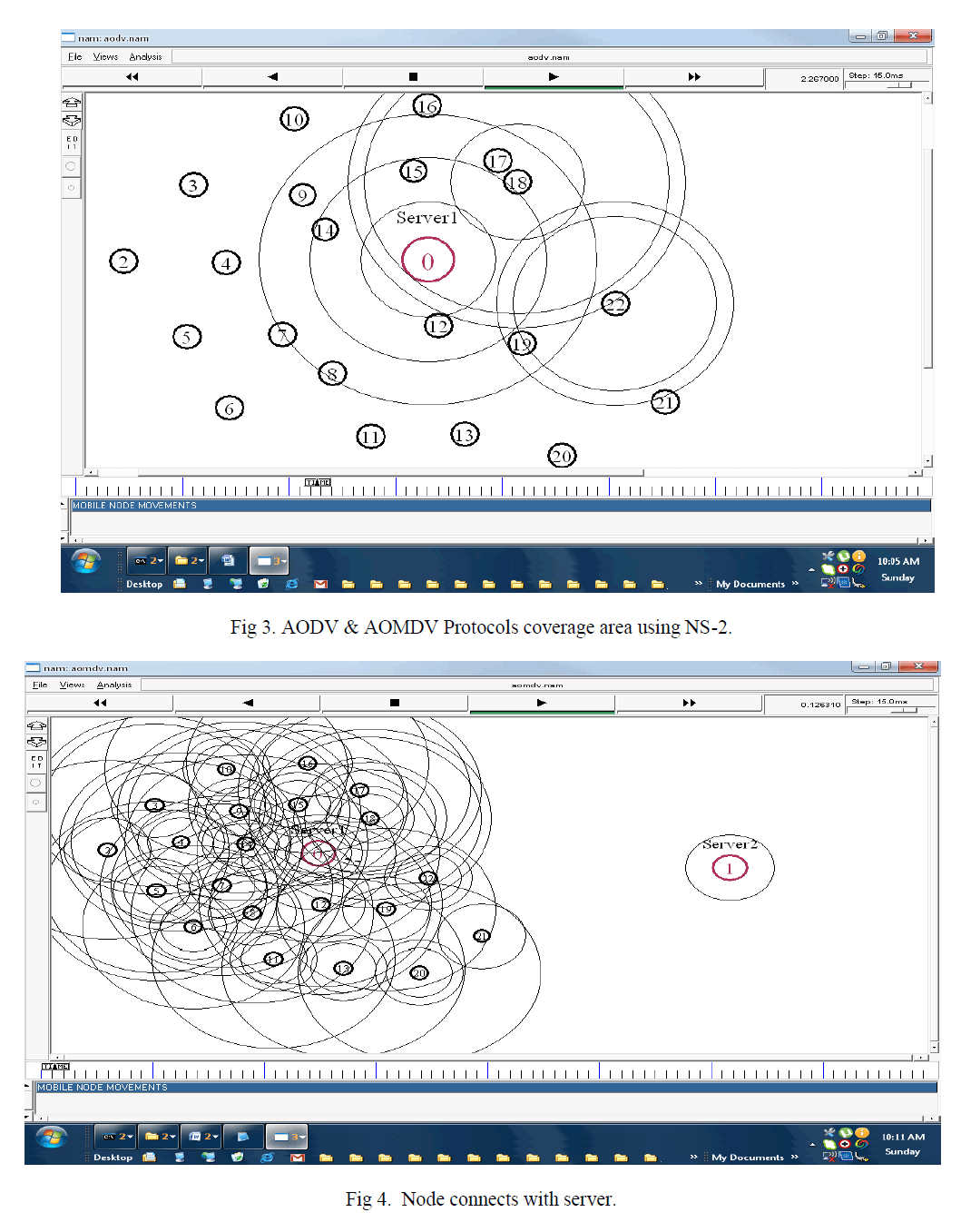 |
| In Figure 4 Server 1 is connected with Server 2 using AODV protocol as well as Server 1 is connected with Server 2 using AOMDV protocol. |
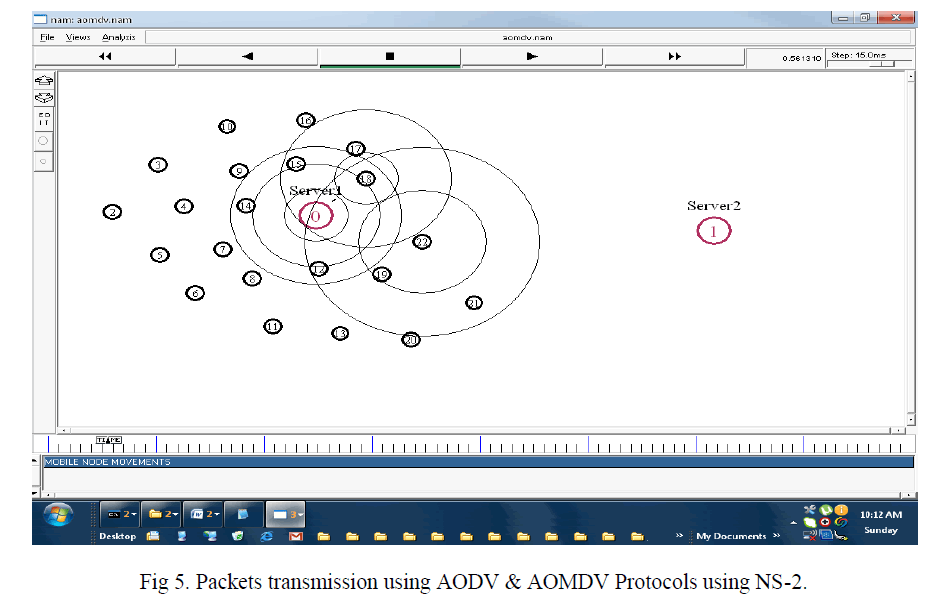 |
| Figure 5 show packets transmission by 20 network nodes from Server 1 to Server 2 using AODV and AOMDV protocols |
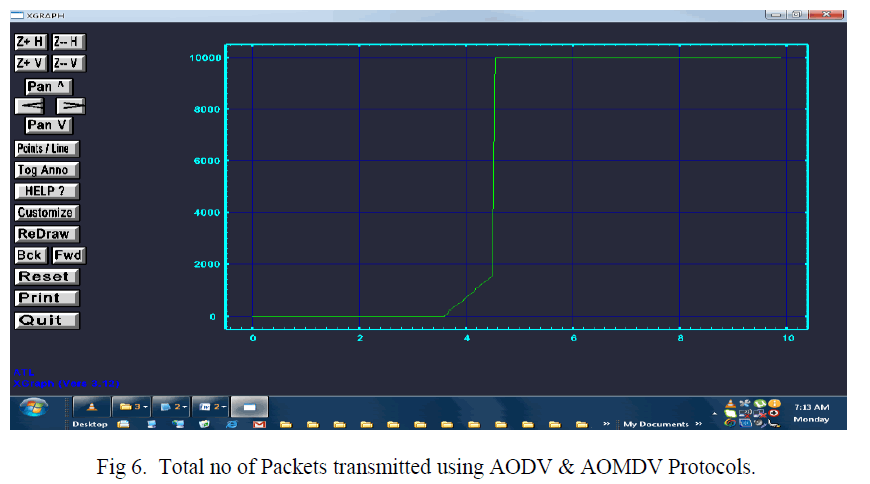 |
| In Figure 6 show 10000 packets are transmitted using AODV protocol and 10000 packets are transmitted using AOMDV protocol. Because the packets transmission rate will same for both scenarios. |
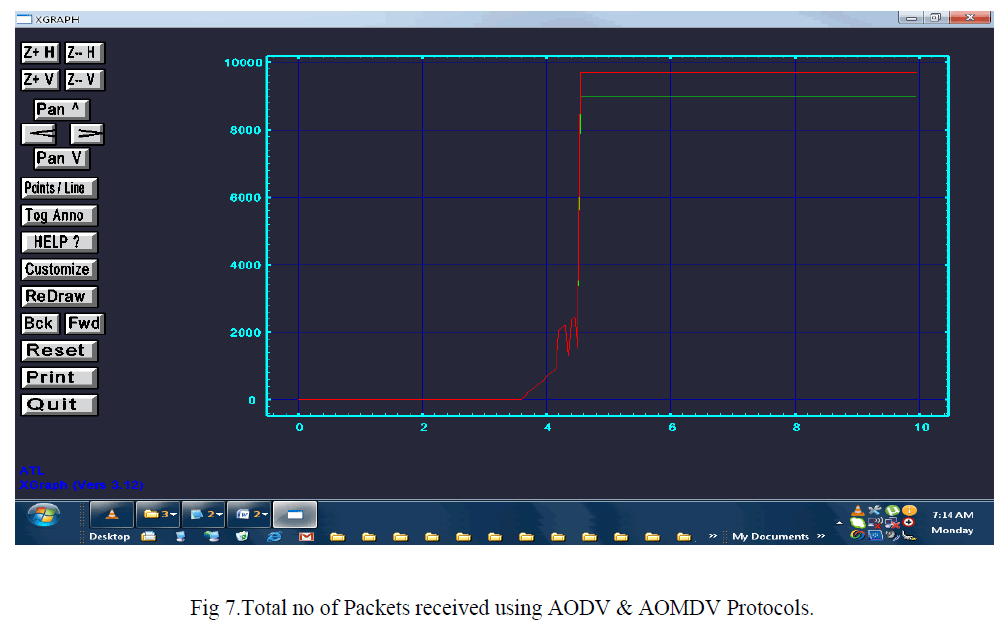 |
| In Figure 7 total no of Packets received using AODV are 9000 that indicate by green line. Total no of Packets received using AOMDV are 9700 that indicate by red line AOMDV Protocols. So Figure 7 Show packets received radio of AODV protocol is minimum. |
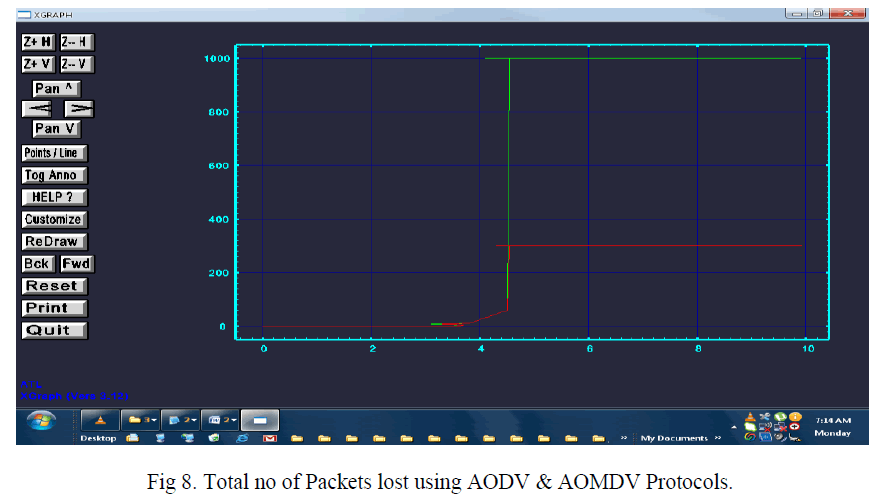 |
| In Figure 8 total no of Packets lost using AODV are 1000 that indicate by green line. Total no of Packets lost using AOMDV are 300 that indicate by red line AOMDV Protocols. So Figure 8 Show packets lost radio of AODV protocol is high. |
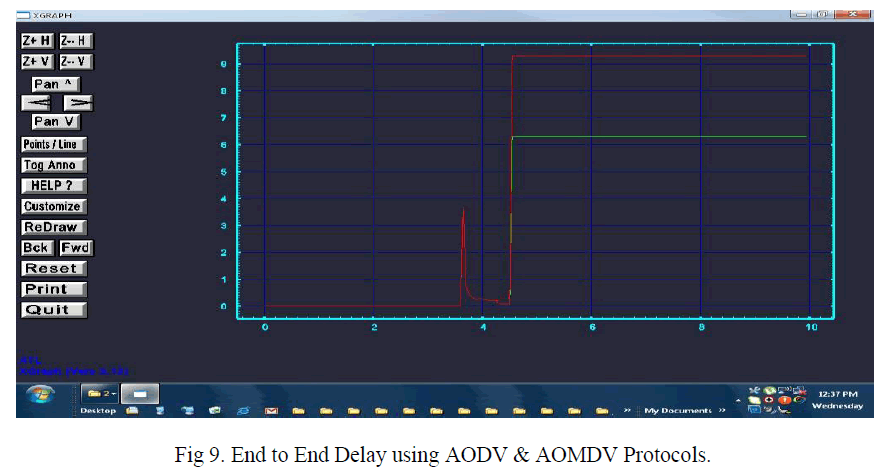 |
| In Figure 9 show End to End delay using AODV is 6 sec/packets. that indicate by green line. End to End delay using AOMDV is 9 sec./packets. So Figure 9 Show of AOMDV protocol takes long time to reestablished connection after link failure. |
 |
III. CONCLUSION & FUTURE WORK
|
| In this paper first the author performed comparative study of AODV and AOMDV based on different metrics using the NS-2 simulator. Based on result packets received and packets lost the AOMDV protocol is gave best performance. But packets received ratio of AODV is minimum and packets lost ratio is maximum. AOMDV suffer with End to End delay. The author analysed problem of both AODV and AOMDV protocols. In future work the author will search new technique to improve the performance of AODV Protocols based on packets received and lost metrics. The author will also work to avoid problem of End to End delay in AOMDV protocol. |
ACKNOWLEDGMENT
|
| My Sincere thanks to CS & IT Department from GGU, his excellence and suggestion is very useful towards this paper to publish. |
References
|
- Shaily Mittal PrabhjotKaur “Performance comparison of AODV, DSR and ZRP Routing Protocols in Manets” International Conferencenon Advances in Computing, Control, and Telecommunication Technologies, 2009.
- Alammari A., Zahary A. and Ayesh A., "Multi path contribution of intermediate nodes in AODV extensions", InternationalConference on Computer Engineering & Systems (ICCES), pp. 347-352, Dec. 2009.
- VipulMaheshwari and ShrikantJadhav, “Survey on MANET Routing Protocol and Multipath Extension in AODV”,International Journal of Applied Information Systems 2(4):1-6, May 2012. Published by Foundation of Computer Science,New York, USA.
- N. Jaisankar, R. Saravanan, “An extended AODV protocol for multipath routing in MANETs”, Internationa l Journal ofEngineering and Technology, Vol.2, No.4, August 2010. [8] THAKER, M; KOSTA, Y; SHARMA,S.B.“Experimental evaluation of single path and multipath routing protocol for MANET”, International Journal of ComputerNetworking, Wireless and Mobile Communications (IJCNWMC), Vol. 2, Issue 4, pp. 27-36, Dec. 2012.
- Vekariya, Swati K.; Manaria, Sumitra; Diwanji, Hiteishi, “Multipath Extension of AODV to Improve End to End Delay”,International Journal of Computer Technology & Applications; 2012, Vol. 3 Issue 3, p1 172, May 2012.
- DavideCerri, Alessandro Ghioni, “Securing AODV: The A-SAODV Secure Routing Prototype”, IEEE CommunicationMagazine, vol. 46, No. 2, Pp. 120-125, February 2008.
- Gupta, Anuj K; Kaur, Jatinder and Kaur, Sandeep, "Comparison of DYMO, AODV, DSR and DSDV MANET routingprotocols over varying traffic", International Journal of Research in Engineering & Applied Science, Vol. 1, Issue 2, pp. 71-83 ,October, 2011.
- A. Mtibaa and F. Kamoun, "MMDV: multipath and MPR based AODV routing protocol," Proc. IFIP 5th AnnualMediterranean Ad Hoc Networking Workshop, pp. 137-144,2006.
- Jain, Simmi; Gupta, Hitesh; Baghel, M. K ., "Survey on MANET Routing Protocol and proposed Multipath Extension inAODV", International Journal of Advanced Research in Computer Science and Software Engineering, Vol. 2, pp. 337- 343,Issue 7, July 2012.
- Veerayya, Mallapur; Sharma, Vishal and AbhayKarandikar,"SQ-AODV: A novel energy-aware stability-based routing protocol for enhanced QoS in wireless ad-hoc networks", Military Communications Conference, 2008. MILCOM 2008.IEEE, pp. 1-7. IEEE, 2008.
- Sunil Taneja and AshwaniKush“A Survey of Routing Protocols in Mobile Ad Hoc Networks” in International Journal of Innovation ,Management and Technology, Vol. 1, No. 3, August 2010 ,ISSN: 2010-0248 .
- PankajPalta and Sonia Goyal,“Comparison of OLSR and TORA Routing Protocols Using OPNET Modeler” in International Journal ofEngineering Research & Technology (IJERT),Vol. 1 Issue 5, July – 2012,ISSN: 2278-0181.
- IEEE 802.11a Working Group, “Wireless LAN Medium Access Control (MAC) and Physical Layer (PHY) specifications – Amendment1: High-speed Physical Layer in the 5 GHz band,” 1999.
- M.K.Marina and S.R.Das, “On-Demand multipath distance vector routing in ad hoc networks” in: Proceedings of the 9th IEEEInternational Conference on Network Protocols (ICNP), 2001.
- S.R.Das, R.Casteneda, J.Yan, “Simulation based performance evaluation of mobile, ad hoc network routing protocols” in:ACM/BaltzerMobile Networks andApplications (MONET) Journal, July 2000.
- C.E.Perkins, E.M.Belding-Royer and I.D.Chakeres, “Ad hoc On- Demand Distance Vector (AODV) Routing”, IETF Internet Draft, draftperkins-manet-aodvbis-01.txt. January 2004.
|